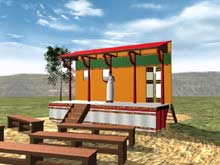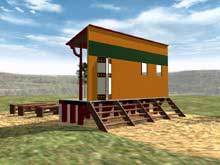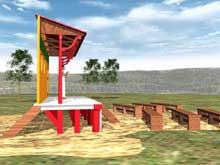Visual Resources
The Greek Comic Stage
By the THEATRON consortium
Numerous vases found in southern Italy dating from around 400 – 325 BC depict comic scenes. The subject matter of the comedies appears to have been either the parodying of myths (especially the way in which myths were presented in Athenian tragedy) or depictions of comic scenes from everyday life. The characters depicted on the earlier vases (c.400 – c.365 BC, mostly from Tarentum) are usually grotesque, wearing padded costumes and tights, masks, cloaks, tunics, and armour, and the males are invariably outfitted with a prominent phallus. Previously thought to be a local form of drama, recent scholarship has shown that the vases probably depict Athenian ('Old') comedy, such as that by Aristophanes and his contemporaries, and that certain vases even require a knowledge of specific plays by Aristophanes (see Taplin 1993). During the 360s BC, the vases began to depict the kind of 'social' comedy that then dominated the Athenian stage.
The vases (formerly called 'phlyax' vases) show a raised platform, varying in height, resting on wooden posts, with a decorated rear wall made from panels of wood or canvas. This backdrop often had a doorway opening onto the stage through which the actors would have entered, and occasionally had window openings that may have been employed for comic purposes. The space behind the backdrop was probably used as a tiring area, and also to store stage properties. A short flight of steps, varying in number from 6-8, stood at the front of the platform, suggesting a stage height of approximately 1 metre. Draperies were often hung from the edge of the stage to the ground to mask the wooden posts on which the platform was stood. The vases indicate that both the stage and the ground around it was used for performance, as many depict actors climbing the stairs leading to the platform or stood apart from the stage looking on.
The stages sometimes had a small roof protruding from the rear wall sheltering the stage, held aloft by wooden supports attached to the posts of the main structure. These supports were usually decorated, often to resemble one of the classical orders. Other stage properties depicted on the vases, include small porches and alters, baskets, chests, tables, weapons and chairs. It is undetermined whether the stages were permanent or whether they were temporary and the property of travelling troupes. The stages appear very simple in structure implying that they were capable of being dismantled and transported. However, some scholars have argued that the stages were depicted in a simplified manner because of the limited space available to the vase painters.
Further reading: Taplin, Oliver Comic Angels (Oxford: Clarendon Press, 1993)
 |
 |
 |
| View from the front | View from behind | View fron the side |
Images copyright the University of Warwick. Created by the THEATRON Consortium.
For more information on THEATRON please visit www.theatron.org
